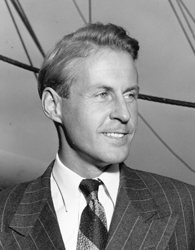Norwegian archeologist and anthropologist Thor Heyerdahl made harrowing transoceanic expeditions in reconstructions of ancient vessels to gain evidence for his controversial theories on human migration, gaining popular attention if not wide scientific acceptance.
Thor Heyerdahl’s Early Days
Thor Heyerdahl was born in Larvik, Norway, on October 6, 1914. His father was a brewer and his mother was chairwoman of the local museum association. His mother introduced a young Heyerdahl to zoology and allowed him to have a small zoo in his father’s brewery. His childhood interest in animals and nature led him to enroll at the University of Oslo, where he studied biology and geography.
In 1936, Heyerdahl left the university with his wife, Liv, to travel to Tahiti. Once there, Teriieroo, the island’s supreme chief, educated the couple in Polynesian culture and customs. Heyerdahl and his wife then moved to Fatu-Hiva in the Marquesas. They spent the next year living a traditional Polynesian lifestyle, and studying the origins of the native animals and plants.
During his time at Fatu-Hiva, Heyerdahl began to wonder how the Polynesians came to inhabit these remote islands in the first place. Heyerdahl noted that currents in the Pacific Ocean moved from east to west, making a transoceanic voyage from South America to Polynesia possible. This, and Heyerdahl’s realization that some plant life in Polynesia was identical to that in South America, led him to theorize that Polynesian civilizations had in fact originated in South America. Heyerdahl traveled to Canada, where he researched his new theory at the Museum of British Columbia. He concluded that Polynesia had been originally settled by seafarers from Peru and Easter Island; later, a group from British Columbia established itself in Hawaii.
Sources in this Story
- The Kon-Tiki Museum: Thor Heyerdahl 1914–2002
- Thor Heyerdahl Expeditions: Thor Heyerdahl
- Bradshaw Foundation: The Kon-Tiki
- The Kon-Tiki Museum: Ra II
- BBC: Explorer Thor Heyerdahl dies
- IMDb: Thor Heyerdahl
Heyerdahl’s Notable Accomplishments
After serving the Free Norwegian Forces in World War II, Heyerdahl began preparations for the first of many expeditions to collect evidence for his theories. On April 27, 1947, the Kon-Tiki set sail from Peru for Polynesia. The small balsa wood raft carried Heyerdahl and his crew of five on a 101-day journey across the Pacific Ocean. The raft landed on an island in the Tuamotu Archipelago after covering 5,000 miles. Heyerdahl had done exactly what he set out to do, to demonstrate that ancient people from South America could have traveled to Polynesia on primitive crafts. Heyerdahl’s book about the Kon-Tiki expedition sold 60 million copies, and the 1950 movie made on the journey won an Oscar for Best Documentary.
In 1952, Heyerdahl led the first archeological expedition to the Galapagos Islands. Three years later, he led another archeological expedition, this time to Easter Island. While there, Heyerdahl became interested in reed boats, and developed a theory that ancient civilizations could have used these papyrus-reed ships to cross the Pacific and Atlantic Oceans. In 1970, Heyerdahl set out from Morocco in a reed ship named Ra II in an attempt to demonstrate the possibility. The Ra II traveled nearly 4,000 miles across the Atlantic Ocean in 57 days, landing on Barbados in the West Indies.
Heyerdahl’s final famous journey, 1977’s Tigris expedition, took him and a small crew across the Indian Ocean from Iraq to Africa in a large reed ship in 1977. After five months on the sea, the Heyerdahl and his crew reached the journey’s end near Djibouti. When local conflicts barred the Tigris from entering the Red Sea, Heyerdahl burned the ship in protest.
Thor Heyerdahl and his Work
The Rest of the Story
During the Ra II expedition, Heyerdahl had been angered by the amount of garbage he saw floating in the ocean. During the voyage he said, “We seem to believe the ocean is endless…we use it like a sewer.” Heyerdahl became an outspoken advocate for the environment, making speeches to the United Nations on the subject.
Heyerdahl died of cancer in Colla Micheri, Italy, on April 18, 2002. He left behind a well-documented legacy, publishing many books about his research and directing four movies about his expeditions. Oslo, Norway, is home to a museum dedicated to his work. Today, Heyerdahl is remembered by the scientific community for his controversial views on human migration, many of which are still not widely accepted.
This article was originally written by Caleb March; it was updated October 11, 2017.











